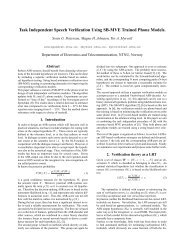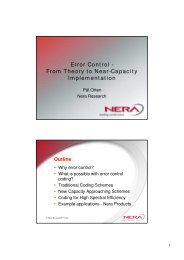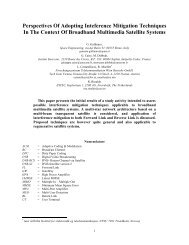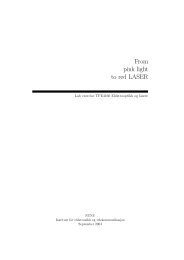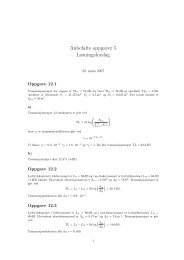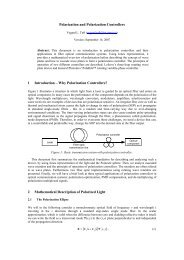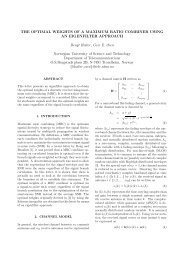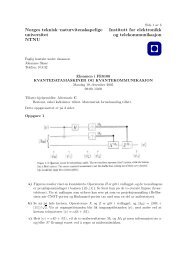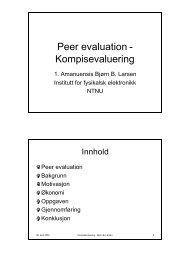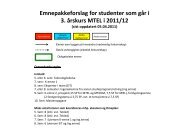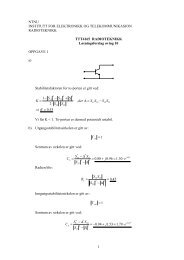Opportunistic Multiuser Scheduling for Wireless Channels - NTNU
Opportunistic Multiuser Scheduling for Wireless Channels - NTNU
Opportunistic Multiuser Scheduling for Wireless Channels - NTNU
You also want an ePaper? Increase the reach of your titles
YUMPU automatically turns print PDFs into web optimized ePapers that Google loves.
<strong>Opportunistic</strong> <strong>Multiuser</strong> <strong>Scheduling</strong> <strong>for</strong><br />
<strong>Wireless</strong> <strong>Channels</strong><br />
Lecture in “Communication Theory <strong>for</strong> <strong>Wireless</strong> <strong>Channels</strong>”<br />
Vegard Hassel — October 25, 2004<br />
<strong>Opportunistic</strong> <strong>Multiuser</strong> <strong>Scheduling</strong> <strong>for</strong> <strong>Wireless</strong> <strong>Channels</strong> 1
Outline - I<br />
• System model<br />
• What is opportunistic scheduling?<br />
• <strong>Multiuser</strong> diversity<br />
• <strong>Scheduling</strong> concepts<br />
• HDR example<br />
• Calculating MASSE<br />
<strong>Opportunistic</strong> <strong>Multiuser</strong> <strong>Scheduling</strong> <strong>for</strong> <strong>Wireless</strong> <strong>Channels</strong> 2
Outline - II<br />
• <strong>Scheduling</strong> schemes:<br />
– Algorithms that consider the channel conditions and feedback<br />
reduction<br />
– Algorithms that consider fairness<br />
– Algorithms that consider delay and power<br />
– Algorithms that consider QoS<br />
– An algorithm <strong>for</strong> a MIMO system<br />
– An algorithm <strong>for</strong> an OFDM system<br />
– Relay-aided algorithm<br />
• <strong>Scheduling</strong> and cross-layer design<br />
<strong>Opportunistic</strong> <strong>Multiuser</strong> <strong>Scheduling</strong> <strong>for</strong> <strong>Wireless</strong> <strong>Channels</strong> 3
System Model - I<br />
<strong>Opportunistic</strong> <strong>Multiuser</strong> <strong>Scheduling</strong> <strong>for</strong> <strong>Wireless</strong> <strong>Channels</strong> 4
System Model - II<br />
• Time Division Multiplexed (TDM) system<br />
• Uplink (user transmits) and down-link (user receives) at different<br />
frequencies<br />
• N users<br />
• Most algorithms assume that the users’ carrier-to-noise-ratios (CNR)<br />
are i.i.d.<br />
<strong>Opportunistic</strong> <strong>Multiuser</strong> <strong>Scheduling</strong> <strong>for</strong> <strong>Wireless</strong> <strong>Channels</strong> 5
What is <strong>Opportunistic</strong> <strong>Scheduling</strong>?<br />
• The traditional TDM scheduling algorithm has been Round robin<br />
(GSM)<br />
– The time-slots are assigned to the users in a sequential manner,<br />
independently of the channel conditions<br />
– Resource fair, but not necessary per<strong>for</strong>mance fair<br />
• <strong>Opportunistic</strong> scheduling exploits the varying quality of the fading<br />
channel to increase the Maximum Average System Spectral Efficiency<br />
(MASSE)<br />
• The future challenge will be to design algorithms that are both<br />
opportunistic and operates according to the QoS-demands from the<br />
applications<br />
• Efficient adaptive modulation and coding is necessary to implement the<br />
scheduling algorithms<br />
[1]<br />
<strong>Opportunistic</strong> <strong>Multiuser</strong> <strong>Scheduling</strong> <strong>for</strong> <strong>Wireless</strong> <strong>Channels</strong> 6
<strong>Multiuser</strong> Diversity (MUD)<br />
• Diversity in wireless systems arises because of independently fading<br />
channels<br />
• Traditional <strong>for</strong>ms of diversity: space, time and frequency<br />
• Viswanath and Tse: <strong>Multiuser</strong> diversity, MUD<br />
• Background: With many users in a cell, there is high probability of<br />
finding a user with a good channel at any time<br />
• MUD concept: To obtain the highest rate, the user with the best<br />
channel has to be chosen at all times<br />
• Observe: While traditional <strong>for</strong>ms of diversity gives better link spectral<br />
efficiency, multiuser diversity increases the system (sum) spectral<br />
efficiency<br />
[1]<br />
<strong>Opportunistic</strong> <strong>Multiuser</strong> <strong>Scheduling</strong> <strong>for</strong> <strong>Wireless</strong> <strong>Channels</strong> 7
<strong>Scheduling</strong> Concepts<br />
• <strong>Scheduling</strong> policy - a rule that specifies which user is allowed to<br />
transmit and which user is allowed to receive at each time-slot (Q(t))<br />
• Feasible - a policy that satisfies the QoS-constraints from all users<br />
• Throughput optimal - an algorithm that manages to keep all queues<br />
stable and still fulfill the QoS-requirements<br />
[2, 3]<br />
<strong>Opportunistic</strong> <strong>Multiuser</strong> <strong>Scheduling</strong> <strong>for</strong> <strong>Wireless</strong> <strong>Channels</strong> 8
HDR Example - I<br />
Algorithm implemented in the High Data Rate (HDR) products from<br />
Qualcomm<br />
• The channel conditions <strong>for</strong> each user is independent<br />
• The channel is GOOD 50% of the time and BAD 50% of the time<br />
• Two users with bitrates (Markov channel):<br />
– User 1: 200Mbit/s or 400Mbit/s<br />
– User 2: 400Mbit/s or 800Mbit/s<br />
– The users cannot be active at the same time<br />
• Round robin algorithm without opportunistic scheduling:<br />
– R1=0.5*(0.5*200Mbit/s+0.5*400Mbit/s)=150Mbit/s<br />
– R2=0.5*(0.5*400Mbit/s+0.5*800Mbit/s)=300Mbit/s<br />
[3]<br />
<strong>Opportunistic</strong> <strong>Multiuser</strong> <strong>Scheduling</strong> <strong>for</strong> <strong>Wireless</strong> <strong>Channels</strong> 9
HDR Example - II<br />
• With opportunistic scheduling, the user that has the GOOD channel<br />
condition is chosen:<br />
– 25% of the time both users have BAD channel<br />
– 50% of the time one user has GOOD channel<br />
– 25% of the time both users have GOOD channel<br />
• The user with the relatively best channel is chosen<br />
• Round robin with opportunistic scheduling:<br />
– R1=0.5*(0.25*200Mbit/s+0.75*400Mbit/s)=175Mbit/s<br />
– R2=0.5*(0.25*400Mbit/s+0.75*800Mbit/s)=350Mbit/s<br />
• <strong>Opportunistic</strong> scheduling gives a 17% capacity gain<br />
• But what if both users need 200Mbit/s?<br />
[3]<br />
<strong>Opportunistic</strong> <strong>Multiuser</strong> <strong>Scheduling</strong> <strong>for</strong> <strong>Wireless</strong> <strong>Channels</strong> 10
Calculating the MASSE<br />
Calculating the Maximum Average System Spectral Efficiency<br />
(MASSE)<br />
Optimum rate adaptation (no power adaptation):<br />
C ora<br />
W<br />
∫ ∞<br />
= log 2 (1 + γ)p γ ∗(γ) dγ<br />
0<br />
Optimum power and rate adaptation:<br />
C opra<br />
W<br />
= ∫ ∞<br />
γ 0<br />
log 2<br />
( γ<br />
γ 0<br />
)<br />
p γ ∗(γ) dγ,<br />
where γ 0 is found from the power constraint:<br />
∫ ∞<br />
γ 0<br />
( 1<br />
− 1 )<br />
p γ ∗(γ) dγ = 1<br />
γ 0 γ<br />
[4]<br />
<strong>Opportunistic</strong> <strong>Multiuser</strong> <strong>Scheduling</strong> <strong>for</strong> <strong>Wireless</strong> <strong>Channels</strong> 11
Algorithms that Consider the Channel Conditions and<br />
Feedback Reduction<br />
• Max CNR <strong>Scheduling</strong>, MCS<br />
• Analyzing Feedback<br />
• Selective <strong>Multiuser</strong> Diversity, SMUD<br />
• Optimal Rate, Reduced Feedback, ORRF<br />
• Nested ORRF, NORRF<br />
• Switched <strong>Scheduling</strong> Algorithms<br />
• Inducing Channel Fluctuations<br />
<strong>Opportunistic</strong> <strong>Multiuser</strong> <strong>Scheduling</strong> <strong>for</strong> <strong>Wireless</strong> <strong>Channels</strong> 12
Rate-Optimal TDM <strong>Scheduling</strong> - I<br />
Ride the peaks!<br />
[5, 6]<br />
<strong>Opportunistic</strong> <strong>Multiuser</strong> <strong>Scheduling</strong> <strong>for</strong> <strong>Wireless</strong> <strong>Channels</strong> 13
Rate-Optimal TDM <strong>Scheduling</strong> - II<br />
The Max CNR scheduling (MCS) policy can be stated as:<br />
i ∗ (t) = argmax<br />
1≤i≤N<br />
γ i (t)<br />
Equivalently:<br />
i ∗ (t) = argmax<br />
1≤i≤N<br />
R i (t)<br />
• Also called the greedy algorithm<br />
• Only fair if the users’ CNRs are i.i.d. (dependent on coherence time)<br />
• Only rate-optimal if the capacity degradation due to feedback is ignored<br />
[5]<br />
<strong>Opportunistic</strong> <strong>Multiuser</strong> <strong>Scheduling</strong> <strong>for</strong> <strong>Wireless</strong> <strong>Channels</strong> 14
Rate-Optimal TDM <strong>Scheduling</strong> - III<br />
The cumulative distribution of the best user is found by using order<br />
statistics:<br />
P γ ∗(γ) = P N γ (γ),<br />
The probability density function (PDF) of the best user is found by<br />
differentiating the cumulative distribution function (CDF) with respect to<br />
γ:<br />
p γ ∗(γ) = N · Pγ<br />
N−1 (γ) · p γ (γ),<br />
For a Rayleigh channel we get the following PDF:<br />
p γ ∗(γ) = N · (1 − e −γ/γ ) N−1 · e−γ/γ<br />
γ<br />
To make integration easier, it is often preferable to use binomial<br />
expansion:<br />
[5]<br />
p γ ∗(γ) = N γ<br />
N−1<br />
∑<br />
n=0<br />
( N − 1<br />
n<br />
)<br />
(−1) n e −(1+n)γ/γ<br />
<strong>Opportunistic</strong> <strong>Multiuser</strong> <strong>Scheduling</strong> <strong>for</strong> <strong>Wireless</strong> <strong>Channels</strong> 15
Rate-Optimal TDM <strong>Scheduling</strong> - IV<br />
[5]<br />
<strong>Opportunistic</strong> <strong>Multiuser</strong> <strong>Scheduling</strong> <strong>for</strong> <strong>Wireless</strong> <strong>Channels</strong> 16
Analyzing Feedback<br />
• The MCS algorithm assumes that each user feeds back its CNR <strong>for</strong><br />
every time-slot<br />
• We will look at how to reduce the feedback load of the MCS algorithm<br />
• Normalized Feedback load (NFL) is defined as the average ratio of users<br />
that give feedback <strong>for</strong> every time-slot<br />
• To analyze the feedback in depth it is also interesting to investigate the<br />
feedback rate, i.e. the number of bits that are fed back <strong>for</strong> every<br />
time-slot<br />
<strong>Opportunistic</strong> <strong>Multiuser</strong> <strong>Scheduling</strong> <strong>for</strong> <strong>Wireless</strong> <strong>Channels</strong> 17
SMUD: Selective <strong>Multiuser</strong> Diversity - I<br />
• Algorithm that reduces the feedback load by using a CNR threshold<br />
• The scheduler asks <strong>for</strong> the instantaneous CNR level only from the users<br />
that have CNR above a threshold, γ th<br />
• If none of the users feed back their CNR, a random user is chosen<br />
• The algorithm is not rate-optimal, but gives a significant reduction in<br />
the feedback load<br />
i ∗ (t) =<br />
⎧<br />
⎨<br />
⎩<br />
rand(i),<br />
argmax<br />
1≤i≤N<br />
γ i (t),<br />
if all γ i (t) ≤ γ th<br />
if it exists a γ i (t) > γ th<br />
[7]<br />
<strong>Opportunistic</strong> <strong>Multiuser</strong> <strong>Scheduling</strong> <strong>for</strong> <strong>Wireless</strong> <strong>Channels</strong> 18
SMUD: Selective <strong>Multiuser</strong> Diversity - II<br />
CDF:<br />
P γ ∗(γ) =<br />
{<br />
P<br />
N−1<br />
γ (γ th ) · P γ (γ), γ ≤ γ th<br />
Pγ N (γ),<br />
γ > γ th<br />
PDF can be found by differentiating the CDF with respect to γ:<br />
p γ ∗(γ) =<br />
{<br />
P<br />
N−1<br />
γ (γ th ) · p γ (γ), γ ≤ γ th<br />
N · Pγ N−1 (γ) · p γ (γ), γ > γ th<br />
The NFL <strong>for</strong> the SMUD algorithm can be shown to be given by:<br />
¯F = 1 − P γ (γ th )<br />
[7]<br />
<strong>Opportunistic</strong> <strong>Multiuser</strong> <strong>Scheduling</strong> <strong>for</strong> <strong>Wireless</strong> <strong>Channels</strong> 19
SMUD: Selective <strong>Multiuser</strong> Diversity - III<br />
[7]<br />
<strong>Opportunistic</strong> <strong>Multiuser</strong> <strong>Scheduling</strong> <strong>for</strong> <strong>Wireless</strong> <strong>Channels</strong> 20
ORRF: Optimal-Rate, Reduced Feedback - I<br />
• Based on the SMUD algorithm<br />
• If all users fail to meet the CNR threshold value, the base station<br />
requests full feedback<br />
• Obtains optimal rate, but has a significant reduction in feedback<br />
• Disadvantage: Needs more time to collect feedback in<strong>for</strong>mation (guard<br />
interval)<br />
[7, 8]<br />
<strong>Opportunistic</strong> <strong>Multiuser</strong> <strong>Scheduling</strong> <strong>for</strong> <strong>Wireless</strong> <strong>Channels</strong> 21
ORRF: Optimal-Rate, Reduced Feedback - II<br />
[8]<br />
<strong>Opportunistic</strong> <strong>Multiuser</strong> <strong>Scheduling</strong> <strong>for</strong> <strong>Wireless</strong> <strong>Channels</strong> 22
ORRF: Optimal-Rate, Reduced Feedback - III<br />
For the ORRF algorithm, it can be shown that the normalized average<br />
feedback load can be expressed as:<br />
¯F = 1 − P γ (γ th ) + P N γ (γ th ), N = 2, 3, 4, · · ·<br />
Differentiating this expression with regard to γ th and setting the expression<br />
equal to zero gives the optimal threshold value:<br />
γ ∗ th = P −1<br />
γ ∗<br />
( ( 1<br />
N<br />
) 1<br />
)<br />
N−1<br />
, N = 2, 3, 4, · · ·,<br />
For a Rayleigh channel this expression is given as:<br />
γ ∗ th = −γ ln(1 − (1/N) 1<br />
N−1), N = 2, 3, 4, · · ·,<br />
[8]<br />
<strong>Opportunistic</strong> <strong>Multiuser</strong> <strong>Scheduling</strong> <strong>for</strong> <strong>Wireless</strong> <strong>Channels</strong> 23
ORRF: Optimal-Rate, Reduced Feedback - IV<br />
[8]<br />
<strong>Opportunistic</strong> <strong>Multiuser</strong> <strong>Scheduling</strong> <strong>for</strong> <strong>Wireless</strong> <strong>Channels</strong> 24
ORRF: Optimal-Rate, Reduced Feedback - V<br />
Delays can be analyzed using two different scenarios:<br />
• Scenario 1: <strong>Scheduling</strong> delay:<br />
– Arises because the scheduler received channel estimates, takes a<br />
scheduling decision and notifies the selected user<br />
– The selected user transmits using a constellation size based on a<br />
channel estimate without delay<br />
– When the user is transmitting, it doesn’t necessarily have to be the<br />
best anymore. There<strong>for</strong>e, we will experience a degradation in MASSE<br />
compared to the optimal rate<br />
[8]<br />
<strong>Opportunistic</strong> <strong>Multiuser</strong> <strong>Scheduling</strong> <strong>for</strong> <strong>Wireless</strong> <strong>Channels</strong> 25
ORRF: Optimal-Rate, Reduced Feedback - VI<br />
• Scenario 2: Outdated channel estimates:<br />
– Leads to both a scheduling delay and suboptimal modulation<br />
constellations with increased BER<br />
– Both the scheduling decision and the decision of the modulation<br />
constellation is based on an outdated channel estimate<br />
– The selected user experiences a CNR degradation, but does not adjust<br />
its modulation constellation accordingly (as <strong>for</strong> the previous scenario)<br />
– The rate is not lowered, but the BER will increase with the degree of<br />
outdatedness<br />
[8]<br />
<strong>Opportunistic</strong> <strong>Multiuser</strong> <strong>Scheduling</strong> <strong>for</strong> <strong>Wireless</strong> <strong>Channels</strong> 26
ORRF: Optimal-Rate, Reduced Feedback - VII<br />
[8]<br />
<strong>Opportunistic</strong> <strong>Multiuser</strong> <strong>Scheduling</strong> <strong>for</strong> <strong>Wireless</strong> <strong>Channels</strong> 27
ORRF: Optimal-Rate, Reduced Feedback - VIII<br />
[8]<br />
<strong>Opportunistic</strong> <strong>Multiuser</strong> <strong>Scheduling</strong> <strong>for</strong> <strong>Wireless</strong> <strong>Channels</strong> 28
NORRF: Nested ORRF - I<br />
• Employs multiple (nested) feedback thresholds<br />
• Denoting the thresholds by γ th,L >γ th,L−1 > · · ·>γ th,0 (γ th,L = ∞ and<br />
γ th,0 = 0)<br />
• The base station initially requests feedback from those users whose<br />
CNR is above γ th,L−1 . If there are none, the threshold is successively<br />
lowered to γ th,L−2 , γ th,L−3 , · · ·, γ th,0<br />
• The best user is always selected, but the average feedback load is<br />
significantly reduced compared to the MCS algorithm<br />
[9]<br />
<strong>Opportunistic</strong> <strong>Multiuser</strong> <strong>Scheduling</strong> <strong>for</strong> <strong>Wireless</strong> <strong>Channels</strong> 29
NORRF: Nested ORRF - II<br />
For the NORRF algorithm the feedback load can be expressed as:<br />
¯F NORRF = 1 N<br />
L−1<br />
∑<br />
N∑<br />
l=0 n=1<br />
( ) N<br />
n (P γ (γ th,l+1 ) − P γ (γ th,l )) n · Pγ N−n (γ th,l )<br />
n<br />
Using the binomial expansion <strong>for</strong>mula, it can be shown that this expression<br />
can be written as:<br />
¯F NORRF =<br />
L−1<br />
∑<br />
l=0<br />
(P γ (γ th,l+1 ) − P γ (γ th,l )) · P N−1<br />
γ (γ th,l+1 )<br />
[9]<br />
<strong>Opportunistic</strong> <strong>Multiuser</strong> <strong>Scheduling</strong> <strong>for</strong> <strong>Wireless</strong> <strong>Channels</strong> 30
NORRF: Nested ORRF - III<br />
Taking the gradient of this expression with regard to the thresholds γ th,l<br />
and setting the result equal to zero yields:<br />
γ ∗ th,l = P −1<br />
γ<br />
(S l · P γ (γ th,l+1 )) , l = 1, 2, 3, · · ·, L−1<br />
Pγ<br />
−1 (·) is the inverse CDF of the CNR <strong>for</strong> a single user<br />
The expression <strong>for</strong> S l is:<br />
S l =<br />
where N ≥ 2.<br />
{<br />
N<br />
1<br />
1−N , l = 1<br />
[N − (N − 1)S l−1 ]<br />
1<br />
1−N ,<br />
l = 2, 3, · · ·, L−1<br />
[9]<br />
<strong>Opportunistic</strong> <strong>Multiuser</strong> <strong>Scheduling</strong> <strong>for</strong> <strong>Wireless</strong> <strong>Channels</strong> 31
NORRF: Nested ORRF - IV<br />
[9]<br />
<strong>Opportunistic</strong> <strong>Multiuser</strong> <strong>Scheduling</strong> <strong>for</strong> <strong>Wireless</strong> <strong>Channels</strong> 32
Switched <strong>Scheduling</strong> Algorithms - I<br />
• Key observation: algorithms originally devised to select between<br />
antennas in a spatial diversity combiner may also be applied as<br />
multiuser access schemes<br />
• The switched algorithms work as follows:<br />
– The base station probes users in a sequential fashion<br />
– If a probed user is under a CNR threshold, the next user is probed<br />
– The probing process continues until a good enough user is found or<br />
all N users have been checked<br />
– The sequential probing process is done during a guard interval<br />
[10]<br />
<strong>Opportunistic</strong> <strong>Multiuser</strong> <strong>Scheduling</strong> <strong>for</strong> <strong>Wireless</strong> <strong>Channels</strong> 33
Switched <strong>Scheduling</strong> Algorithms - II<br />
The expression <strong>for</strong> the feedback load is the same <strong>for</strong> all the switched<br />
algorithms:<br />
¯F SWITCH = 1 N<br />
1 − P N γ (γ th )<br />
1 − P γ (γ th )<br />
[10]<br />
<strong>Opportunistic</strong> <strong>Multiuser</strong> <strong>Scheduling</strong> <strong>for</strong> <strong>Wireless</strong> <strong>Channels</strong> 34
Switched <strong>Scheduling</strong> Algorithms - III<br />
Scan-and-Wait Transmission, SWT<br />
• The base station probes users in a sequential fashion<br />
• If the scheduler fails to find a good enough user, there is a deliberate<br />
outage <strong>for</strong> one coherence time<br />
• The PDF can be given by:<br />
p γSWT (γ) =<br />
{<br />
pγ (γ)<br />
1−P γ (γ th )<br />
γ ≥ γ th<br />
0 γ < γ th<br />
p γSWT (γ) =<br />
{ ∑N−1<br />
n=0 [P γ(γ th )] n p γ (γ) γ ≥ γ th<br />
[P γ (γ th )] N−1 p γ (γ) γ < γ th<br />
[10]<br />
<strong>Opportunistic</strong> <strong>Multiuser</strong> <strong>Scheduling</strong> <strong>for</strong> <strong>Wireless</strong> <strong>Channels</strong> 35
Switched <strong>Scheduling</strong> Algorithms - IV<br />
Switch-and-Examine Transmission, SET<br />
• The base station probes users in a sequential fashion<br />
• If the scheduler fails to find a good enough user, the last probed user is<br />
chosen to transmit<br />
p γSET (γ) =<br />
{ ∑N−1<br />
n=0 [P γ(γ th )] n p γ (γ) γ ≥ γ th<br />
[P γ (γ th )] N−1 p γ (γ) γ < γ th<br />
[10]<br />
<strong>Opportunistic</strong> <strong>Multiuser</strong> <strong>Scheduling</strong> <strong>for</strong> <strong>Wireless</strong> <strong>Channels</strong> 36
Switched <strong>Scheduling</strong> Algorithms - V<br />
SET with Post-Selection, SETps<br />
• The base station probes users in a sequential fashion<br />
• If the scheduler fails to find a good enough user, the best user is chosen<br />
• Alternative: To increase the short-term fairness, the user which have<br />
waited the longest time <strong>for</strong> transmission can be chosen<br />
p γSETps (γ) =<br />
{ ∑ N−1<br />
n=0 [P γ(γ th )] n p γ (γ) γ ≥ γ th<br />
N[P γ (γ)] N−1 p γ (γ) γ < γ th<br />
[10]<br />
<strong>Opportunistic</strong> <strong>Multiuser</strong> <strong>Scheduling</strong> <strong>for</strong> <strong>Wireless</strong> <strong>Channels</strong> 37
Switched <strong>Scheduling</strong> Algorithms - VI<br />
[10]<br />
<strong>Opportunistic</strong> <strong>Multiuser</strong> <strong>Scheduling</strong> <strong>for</strong> <strong>Wireless</strong> <strong>Channels</strong> 38
Switched <strong>Scheduling</strong> Algorithms - VII<br />
[10]<br />
<strong>Opportunistic</strong> <strong>Multiuser</strong> <strong>Scheduling</strong> <strong>for</strong> <strong>Wireless</strong> <strong>Channels</strong> 39
Switched <strong>Scheduling</strong> Algorithms - VIII<br />
[10]<br />
<strong>Opportunistic</strong> <strong>Multiuser</strong> <strong>Scheduling</strong> <strong>for</strong> <strong>Wireless</strong> <strong>Channels</strong> 40
Inducing Channel Fluctuations - I<br />
• If the channel fluctuations are too small, no MUD gain will be<br />
experienced<br />
• This is mainly a problem <strong>for</strong> static users<br />
• By using multiple TX-antennas which are fed by a randomly varying<br />
amplitude and phase, fluctuations can be induced<br />
• The increase in channel variations <strong>for</strong> the users, will lead to a higher<br />
MUD gain<br />
• Especially efficient when users have different γ<br />
[1, 11]<br />
<strong>Opportunistic</strong> <strong>Multiuser</strong> <strong>Scheduling</strong> <strong>for</strong> <strong>Wireless</strong> <strong>Channels</strong> 41
Inducing Channel Fluctuations - II<br />
[1, 11]<br />
<strong>Opportunistic</strong> <strong>Multiuser</strong> <strong>Scheduling</strong> <strong>for</strong> <strong>Wireless</strong> <strong>Channels</strong> 42
Inducing Channel Fluctuations - III<br />
[1, 11]<br />
<strong>Opportunistic</strong> <strong>Multiuser</strong> <strong>Scheduling</strong> <strong>for</strong> <strong>Wireless</strong> <strong>Channels</strong> 43
Inducing Channel Fluctuations - IV<br />
[1, 11]<br />
<strong>Opportunistic</strong> <strong>Multiuser</strong> <strong>Scheduling</strong> <strong>for</strong> <strong>Wireless</strong> <strong>Channels</strong> 44
Inducing Channel Fluctuations - V<br />
[1, 11]<br />
<strong>Opportunistic</strong> <strong>Multiuser</strong> <strong>Scheduling</strong> <strong>for</strong> <strong>Wireless</strong> <strong>Channels</strong> 45
Algorithms that Consider Fairness - I<br />
• General Algorithm<br />
• <strong>Opportunistic</strong> Round Robin Algorithm<br />
• Proportional Fair Algorithm<br />
<strong>Opportunistic</strong> <strong>Multiuser</strong> <strong>Scheduling</strong> <strong>for</strong> <strong>Wireless</strong> <strong>Channels</strong> 46
Algorithms that Consider Fairness - II<br />
• Fairness can be seen as:<br />
– Time-slots are fairly shared between the users<br />
– Spectral efficiency fairly shared between the users<br />
• Fairness is always considered with regard to time:<br />
– Short-term<br />
– Long-term<br />
<strong>Opportunistic</strong> <strong>Multiuser</strong> <strong>Scheduling</strong> <strong>for</strong> <strong>Wireless</strong> <strong>Channels</strong> 47
Algorithms that Consider Fairness - III<br />
General Algorithm with a Short-Term Fairness Constraint<br />
Optimization problem <strong>for</strong> window size of M time-slots:<br />
max<br />
M−1<br />
∑<br />
t=0<br />
N∑<br />
E[R i (t)I Q(t)=i ]<br />
i=1<br />
Subject to the constraint:<br />
M−1<br />
∑<br />
t=0<br />
I Q(t)=i ≥ Mφ i<br />
R i (t): Instantaneous rate in time-slot t<br />
Q(t): <strong>Scheduling</strong> policy<br />
I Q(t)=i : Indicator function which is one when the ith user is chosen and<br />
zero otherwise<br />
φ i : The minimum share of time-slots allocated to user i<br />
[12]<br />
<strong>Opportunistic</strong> <strong>Multiuser</strong> <strong>Scheduling</strong> <strong>for</strong> <strong>Wireless</strong> <strong>Channels</strong> 48
Algorithms that Consider Fairness - IV<br />
<strong>Opportunistic</strong> Round Robin Algorithm<br />
The optimization problem is a special case of the general algorithm with<br />
M = N and φ i = 1/N:<br />
max<br />
N−1<br />
∑<br />
t=0<br />
N∑<br />
E[R i (t)I Q(t)=i ]<br />
i=1<br />
Subject to the constraint:<br />
N−1<br />
∑<br />
t=0<br />
I Q(t)=i = 1<br />
Each user has to be selected once within a time window of N time-slots<br />
[12, 6]<br />
<strong>Opportunistic</strong> <strong>Multiuser</strong> <strong>Scheduling</strong> <strong>for</strong> <strong>Wireless</strong> <strong>Channels</strong> 49
Algorithms that Consider Fairness - V<br />
Proportional Fair Algorithm<br />
Implemented in Qualcomm’s HDR (CDMA2000/1xEV) standard<br />
Step 1: Choose the user with the highest relative bit-rate<br />
Step 2: Update the average rate<br />
C i (t + 1) =<br />
i ∗ (t) = argmax<br />
1≤i≤N<br />
( )<br />
Ri (t)<br />
C i (t)<br />
(<br />
1 − 1<br />
t C<br />
)<br />
C i (t) + 1<br />
t C<br />
R i (t)I Q(t)=i<br />
C i (t): Average rate over a time window t C<br />
[13]<br />
<strong>Opportunistic</strong> <strong>Multiuser</strong> <strong>Scheduling</strong> <strong>for</strong> <strong>Wireless</strong> <strong>Channels</strong> 50
Algorithms that Consider Fairness - VI<br />
PF-algorithm: tries to serve each user near its peak.<br />
[11]<br />
<strong>Opportunistic</strong> <strong>Multiuser</strong> <strong>Scheduling</strong> <strong>for</strong> <strong>Wireless</strong> <strong>Channels</strong> 51
Algorithms that Consider Fairness - VII<br />
Mobile environment: The channel varies faster<br />
[11]<br />
<strong>Opportunistic</strong> <strong>Multiuser</strong> <strong>Scheduling</strong> <strong>for</strong> <strong>Wireless</strong> <strong>Channels</strong> 52
Algorithms that Consider Fairness - VIII<br />
Mobile environment: 3km/h, Rayleigh fading<br />
Fixed environment: 2Hz Rician fading with E fixed /E scattered<br />
[11]<br />
<strong>Opportunistic</strong> <strong>Multiuser</strong> <strong>Scheduling</strong> <strong>for</strong> <strong>Wireless</strong> <strong>Channels</strong> 53
Algorithms that Consider Delay and Power<br />
• Analysis of MCS Packet Delay<br />
• Lazy Scheduler with a Deadline<br />
<strong>Opportunistic</strong> <strong>Multiuser</strong> <strong>Scheduling</strong> <strong>for</strong> <strong>Wireless</strong> <strong>Channels</strong> 54
MCS Packet Delay<br />
Packet delay <strong>for</strong> MCS algorithm assuming constant packet length:<br />
[14]<br />
<strong>Opportunistic</strong> <strong>Multiuser</strong> <strong>Scheduling</strong> <strong>for</strong> <strong>Wireless</strong> <strong>Channels</strong> 55
Algorithms that Consider the Tradeoff Energy-Delay - I<br />
• Trade-off between power and delay<br />
[15, 16, 17, 18]<br />
<strong>Opportunistic</strong> <strong>Multiuser</strong> <strong>Scheduling</strong> <strong>for</strong> <strong>Wireless</strong> <strong>Channels</strong> 56
Algorithms that Consider the Tradeoff Energy-Delay - II<br />
Lazy Scheduler with a Deadline - I<br />
• The goal is to minimize the transmission energy subject to a delay<br />
constraint<br />
• Key observation: in many coding schemes, the energy required to<br />
transmit a packet can be significantly reduced by lowering transmission<br />
power and transmitting the packet over a longer period of time<br />
• Because in<strong>for</strong>mation often is time-critical, transmission times cannot be<br />
made arbitrarily long<br />
• From an optimal offline algorithm (all arrival times known at time 0), a<br />
lazy online algorithm is devised<br />
[17, 18]<br />
<strong>Opportunistic</strong> <strong>Multiuser</strong> <strong>Scheduling</strong> <strong>for</strong> <strong>Wireless</strong> <strong>Channels</strong> 57
Algorithms that Consider the Tradeoff Energy-Delay - III<br />
Lazy Scheduler with a Deadline - II<br />
• The lazy algorithm varies transmission times (τ) <strong>for</strong> packets transmitted<br />
at time t < T , according to a backlog (b):<br />
τ(b, t) =<br />
max<br />
k∈{1,...,M}<br />
{<br />
1<br />
k + b<br />
}<br />
k∑<br />
D i ,<br />
i=1<br />
where M is the random number of packets that arrive in the time<br />
interval [0, T ) and D i are the inter-arrival times of the packets.<br />
[17, 18]<br />
<strong>Opportunistic</strong> <strong>Multiuser</strong> <strong>Scheduling</strong> <strong>for</strong> <strong>Wireless</strong> <strong>Channels</strong> 58
Algorithms that Consider the Tradeoff Energy-Delay - IV<br />
Lazy Scheduler with a Deadline - III<br />
[17, 18]<br />
<strong>Opportunistic</strong> <strong>Multiuser</strong> <strong>Scheduling</strong> <strong>for</strong> <strong>Wireless</strong> <strong>Channels</strong> 59
Algorithms that Consider QoS - I<br />
• M-LWDF with a guarantee that the delay is not longer than a threshold<br />
• M-LWDF with a guarantee that the throughput is not below a threshold<br />
<strong>Opportunistic</strong> <strong>Multiuser</strong> <strong>Scheduling</strong> <strong>for</strong> <strong>Wireless</strong> <strong>Channels</strong> 60
Algorithms that Consider QoS - II<br />
M-LWDF: Modified Largest Weighted Delay First<br />
• Assumes queuing at the base station <strong>for</strong> each user<br />
• The following scheduling policy is used:<br />
i ∗ (t) = argmax<br />
1≤i≤N<br />
(ρ i W i (t)R i (t)) ,<br />
where W i (t) is the head-of-the-line packet delays and ρ i is a constant<br />
<strong>for</strong> controlling delay distributions (priority)<br />
• The algorithms picks the users that have large delays and large<br />
instantaneous bit-rates<br />
• It is surprising that such a simple algorithm is throughput optimal<br />
[3]<br />
<strong>Opportunistic</strong> <strong>Multiuser</strong> <strong>Scheduling</strong> <strong>for</strong> <strong>Wireless</strong> <strong>Channels</strong> 61
Algorithms that Consider QoS - III<br />
M-LWDF does not give a dramatical throughput degradation compared to<br />
the MCS algorithm:<br />
[19]<br />
<strong>Opportunistic</strong> <strong>Multiuser</strong> <strong>Scheduling</strong> <strong>for</strong> <strong>Wireless</strong> <strong>Channels</strong> 62
Algorithms that Consider QoS - IV<br />
M-LWDF: Modified Largest Weighted Delay First<br />
• The M-LWDF algorithm can be modified to provide minimum<br />
throughput guarantees<br />
• The following scheduling policy is used to guarantee minimum<br />
throughput R i (Leaky bucket?):<br />
i ∗ (t) = argmax<br />
1≤i≤N<br />
(ρ i W i (t)R i ) ,<br />
where R i is the constant bucket arrival rate <strong>for</strong> bucket (user) i, W i is<br />
the delay of the longest delay token in bucket and ρ i is a constant <strong>for</strong><br />
controlling the time-scale on which throughput guarantees are provided<br />
[3]<br />
<strong>Opportunistic</strong> <strong>Multiuser</strong> <strong>Scheduling</strong> <strong>for</strong> <strong>Wireless</strong> <strong>Channels</strong> 63
Algorithms <strong>for</strong> MIMO Systems - I<br />
We consider a specific algorithm:<br />
• Each user transmits over a MIMO link<br />
• The base station induces rapid variation by using a transmission<br />
randomizing matrix<br />
• A common pilot is used and each user estimates the mutual in<strong>for</strong>mation<br />
between the sender and the transmitter<br />
• The Proportional fair algorithm is used to schedule the users<br />
[20, 21]<br />
<strong>Opportunistic</strong> <strong>Multiuser</strong> <strong>Scheduling</strong> <strong>for</strong> <strong>Wireless</strong> <strong>Channels</strong> 64
Algorithms <strong>for</strong> MIMO Systems - II<br />
• Maximum mutual in<strong>for</strong>mation between sent and received signal<br />
I(X; Y) = log det(I M + HQH † )<br />
• A non–negative definite Q such that I(X; Y) is maximum and<br />
tr(Q) ≤ P remains to be found<br />
• H known at the transmitter (“waterfilling solution”): Choose Q<br />
diagonal, such that<br />
Q ii = (α − λ −1<br />
i ) + , i = 1, . . . , N<br />
with (·) + max(·, 0), (λ 1 , . . . , λ N ) the eigenvalues of H † H and α such<br />
that ∑ i Q ii = P . The capacity is given by:<br />
[20, 21]<br />
N∑ (<br />
C WF = log(αλi ) ) +<br />
[bits/s/Hz]<br />
i=1<br />
<strong>Opportunistic</strong> <strong>Multiuser</strong> <strong>Scheduling</strong> <strong>for</strong> <strong>Wireless</strong> <strong>Channels</strong> 65
Algorithms <strong>for</strong> MIMO Systems - III<br />
[20, 21]<br />
<strong>Opportunistic</strong> <strong>Multiuser</strong> <strong>Scheduling</strong> <strong>for</strong> <strong>Wireless</strong> <strong>Channels</strong> 66
Algorithms <strong>for</strong> OFDM Systems - I<br />
• N users share M OFDM subchannels<br />
• Two scheduling algorithms are proposed to reduce the feedback load:<br />
– Fixed reporting: Each user feeds back the CNRs of K predetermined<br />
subchannels<br />
– Best reporting: Each user feeds back the CNRs of the K best<br />
subchannels<br />
[22]<br />
<strong>Opportunistic</strong> <strong>Multiuser</strong> <strong>Scheduling</strong> <strong>for</strong> <strong>Wireless</strong> <strong>Channels</strong> 67
Algorithms <strong>for</strong> OFDM Systems - II<br />
[22]<br />
<strong>Opportunistic</strong> <strong>Multiuser</strong> <strong>Scheduling</strong> <strong>for</strong> <strong>Wireless</strong> <strong>Channels</strong> 68
Relay-Aided Algorithm - I<br />
[23]<br />
<strong>Opportunistic</strong> <strong>Multiuser</strong> <strong>Scheduling</strong> <strong>for</strong> <strong>Wireless</strong> <strong>Channels</strong> 69
Relay-Aided Algorithm - II<br />
• An un<strong>for</strong>tunate user relays via a <strong>for</strong>tunate user nearby<br />
• Both link and system/network capacity is increased<br />
• Relay or not criterion:<br />
r ∗ (t) = argmax[min(R s,r , R r,d )]<br />
r<br />
Direct mode when r = d and relaying when r ≠ d<br />
[23]<br />
<strong>Opportunistic</strong> <strong>Multiuser</strong> <strong>Scheduling</strong> <strong>for</strong> <strong>Wireless</strong> <strong>Channels</strong> 70
Embedded Modulation and <strong>Scheduling</strong> - I<br />
• Way to increase system capacity <strong>for</strong> downlink transmission<br />
• Because of fairness constraints, it may be necessary to serve a user with<br />
low CNR<br />
• The base station transmits to this user with a small modulation<br />
constellation<br />
• By using embedded modulation, the base station can transmit to a user<br />
with a higher CNR at the same time<br />
[24]<br />
<strong>Opportunistic</strong> <strong>Multiuser</strong> <strong>Scheduling</strong> <strong>for</strong> <strong>Wireless</strong> <strong>Channels</strong> 71
Embedded Modulation and <strong>Scheduling</strong> - II<br />
[24]<br />
<strong>Opportunistic</strong> <strong>Multiuser</strong> <strong>Scheduling</strong> <strong>for</strong> <strong>Wireless</strong> <strong>Channels</strong> 72
Embedded Modulation and <strong>Scheduling</strong> - III<br />
[24]<br />
<strong>Opportunistic</strong> <strong>Multiuser</strong> <strong>Scheduling</strong> <strong>for</strong> <strong>Wireless</strong> <strong>Channels</strong> 73
<strong>Scheduling</strong> and Cross-Layer Design - I<br />
TCP/IP-layers:<br />
• Application<br />
• Transport (TCP, UDP)<br />
• Internet (IP)<br />
• Network access (MAC, LLC)<br />
• Physical<br />
[25, 26]<br />
<strong>Opportunistic</strong> <strong>Multiuser</strong> <strong>Scheduling</strong> <strong>for</strong> <strong>Wireless</strong> <strong>Channels</strong> 74
<strong>Scheduling</strong> and Cross-Layer Design - II<br />
Today: Some adaptation between neighbouring layers.<br />
Tomorrow: Network stack that take advantage of the interdependencies<br />
between the layers.<br />
Variations follow different time scales:<br />
• SNR variations ~ microseconds<br />
• Congestion of packets ~ seconds<br />
• Cumulative user traffic ~ 10-100 seconds<br />
Goldsmith: Because of the different timescales, adaptation between layers<br />
is reasonable only if problems cannot be fixed locally within a layer.<br />
[25, 26]<br />
<strong>Opportunistic</strong> <strong>Multiuser</strong> <strong>Scheduling</strong> <strong>for</strong> <strong>Wireless</strong> <strong>Channels</strong> 75
References<br />
[1] P. Viswanath, D. N. C. Tse, and R. Laroia, “<strong>Opportunistic</strong> beam<strong>for</strong>ming using dumb antennas,” IEEE Trans. In<strong>for</strong>m.<br />
Theory, vol. 48, pp. 1277–1294, June 2002.<br />
[2] X. Liu, E. K. P. Chong, and N. B. Shroff, “A framework <strong>for</strong> opportunistic scheduling in wireless networks,” in Computer<br />
Networks Journal (Elsevier), vol. 41, pp. 451–474, 2003.<br />
[3] M. Andrews, K. Kumaran, K. Ramanan, A. Stolyar, P. Whiting, and R. Vijayakumar, “Providing quality of service over a<br />
shared wireless link,” IEEE Communications Mag., pp. 150–154, Feb. 2001.<br />
[4] A. J. Goldsmith and P. P. Varaiya, “Capacity of fading channels with channel side in<strong>for</strong>mation,” IEEE Trans. In<strong>for</strong>m.<br />
Theory, vol. IT-43, pp. 1896–1992, Nov. 1997.<br />
[5] R. Knopp and P. A. Humblet, “In<strong>for</strong>mation capacity and power control in single cell multiuser communications,” in IEEE<br />
Int. Conf. on Communications (ICC’95), (Seattle, WA), pp. 331–335, June 1995.<br />
[6] M. Johansson, “Issues in multiuser diversity.”<br />
http://www.signal.uu.se/Research/PCCWIP/Visbyrefs/Johansson Visby04.pdf. Presentation at<br />
WIP/BEATS/CUBAN workshop Wisby, Sweden, Aug. 2004.<br />
[7] D. Gesbert and M.-S. Alouini, “How much feedback is multi-user diversity really worth?,” in IEEE Int. Conf. on<br />
Communications (ICC’04), (Paris, France), pp. 234–238, June 2004.<br />
[8] V. Hassel, M.-S. Alouini, G. E. Øien, and D. Gesbert, “Rate-optimal multiuser scheduling with reduced feedback load and<br />
analysis of delay effects.” Submitted to IEEE Int. Conf. on Comm. (ICC’05), (Seoul, South Korea), May 2005.<br />
[9] V. Hassel, M.-S. Alouini, D. Gesbert, and G. E. Øien, “Minimizing feedback load <strong>for</strong> nested scheduling algorithms.”<br />
Submitted to IEEE Veh. Tech. Conf. (VTC’05-spring), (Stockholm, Sweden), May 2005.<br />
[10] B. Holter, M.-S. Alouini, G. E. Øien, and H.-C. Yang, “<strong>Multiuser</strong> switched diversity transmission.” Accepted <strong>for</strong> IEEE Veh.<br />
Tech. Conf. (VTC’04-spring), (Los Angeles, CA), Sept. 2004.<br />
[11] D. Tse, “<strong>Opportunistic</strong> communication: Smart scheduling and dumb antennas.”<br />
http://www.eecs.berkeley.edu/~dtse/intel128.pdf. Presentation at Intel Jan. 2004.<br />
[12] S. S. Kulkarni and C. Rosenberg, “<strong>Opportunistic</strong> scheduling policies <strong>for</strong> wireless systems with short term fairness<br />
constraints,” in IEEE Global Communications Conf. (GLOBECOM), (San Francisco, CA), pp. 533–537, Dec. 2003.<br />
[13] J. M. Holtzman, “Asymptotic analysis of proporional fair algorithm,” in Proc. IEEE Symp. on Personal, Indoor and Mobile<br />
Radio Communications (PIMRC), vol. 2, (San Diego, CA), pp. F–33–F–37, Sept. 2001.<br />
<strong>Opportunistic</strong> <strong>Multiuser</strong> <strong>Scheduling</strong> <strong>for</strong> <strong>Wireless</strong> <strong>Channels</strong> 76
[14] P. Liu, R. Berry, and M. L. Honig, “Delay-sensitive packet scheduling in wireless networks,” in IEEE <strong>Wireless</strong><br />
Communications and Networking Conf., vol. 3, (New Orleans, LA), pp. 1627–1632, Mar. 2003.<br />
[15] R. A. Berry and R. G. Gallager, “Communication over fading channels with delay constraints,” IEEE Trans. In<strong>for</strong>m. Theory,<br />
vol. 48, pp. 1135–1149, May 2002.<br />
[16] M. Agarwal and A. Puri, “Base station scheduling of requests with fixed deadlines,” in IEEE Joint Conference of the<br />
Computer and Communications Societies (INFOCOM), vol. 2, (New York, NY), pp. 487–496, June 2002.<br />
[17] B. Prabhakar, E. Uysal-Biyikoglu, and A. E. Gamal, “Energy-efficient transmission over a wireless link via lazy packet<br />
scheduling,” in IEEE Joint Conference of the Computer and Communications Societies (INFOCOM), (Anchorage, AK),<br />
pp. 386–394, Apr. 2001.<br />
[18] E. Uysal-Biyikoglu, B. Prabhakar, and A. E. Gamal, “Energy-efficient packet transmission over a wireless link,” IEEE/ACM<br />
Trans. on Networking, vol. 10, pp. 487–499, Aug. 2002.<br />
[19] K. Kim, I. Koo, S. Sung, and K. Kim, “Multiple qos support using m-lwdf in ofdma adaptive resource allocation,” in IEEE<br />
Workshop on Local and Metropolitan Area Networks (LANMAN’04), (San Francisco, CA), pp. 217–222, Apr. 2004.<br />
[20] T. L. Liang Dong and Y.-F. Huang, “<strong>Opportunistic</strong> transmission scheduling <strong>for</strong> multiuser MIMO systems,” in IEEE Int.<br />
Conf. on Acoustics, Speech, and Signal Proc. (ICASSP), vol. 5, (Hong Kong), pp. V65–V68, Apr. 2003.<br />
[21] S. de la Kethulle, “An overview of MIMO systems in wireless communications.” Lecture in Communication Theory <strong>for</strong><br />
<strong>Wireless</strong> <strong>Channels</strong>, <strong>NTNU</strong>, Sept. 2004.<br />
[22] J. Moon and Y.-H. Lee, “Per<strong>for</strong>mance analysis of opportunistic scheduling with partial channel in<strong>for</strong>mation.” Submitted to<br />
IEEE Trans. on <strong>Wireless</strong> Comm.<br />
[23] M. Hu and J. Zhang, “Two novel schemes <strong>for</strong> opportunistic multi-access,” in IEEE Workshop on Multimedia Signal<br />
Processing (MMSP), (St. Thomas, US Virgin Islands), pp. 412–415, Dec. 2002.<br />
[24] L. M. C. Hoo, J. Tellado, and J. M. Cioffi, “<strong>Multiuser</strong> loading algorithms <strong>for</strong> multicarrier systems with embedded<br />
constellations,” in IEEE Int. Conf. on Communications (ICC’00), vol. 2, (New Orelans, LA), pp. 1115–1119, June 2000.<br />
[25] S. Shakkottai, T. S. Rappaport, and P. C. Karlsson, “Cross-layer design <strong>for</strong> wireless networks,” IEEE Communications Mag.,<br />
vol. 41, pp. 74–80, Oct. 2003.<br />
<strong>Opportunistic</strong> <strong>Multiuser</strong> <strong>Scheduling</strong> <strong>for</strong> <strong>Wireless</strong> <strong>Channels</strong> 77
[26] A. J. Goldsmith and S. B. Wicker, “Design challenges <strong>for</strong> energy-constrained ad hoc wireless networks,” IEEE <strong>Wireless</strong><br />
Communications, vol. 9, pp. 8–27, Aug. 2002.<br />
<strong>Opportunistic</strong> <strong>Multiuser</strong> <strong>Scheduling</strong> <strong>for</strong> <strong>Wireless</strong> <strong>Channels</strong> 78



